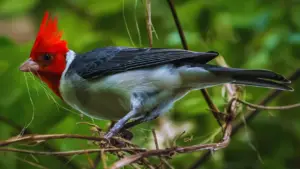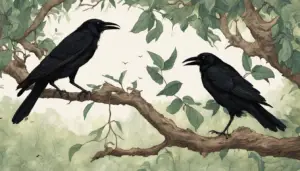Get ready to be amazed by the breathtaking beauty of nature’s feathered wonders! Brace yourself for a jaw-dropping encounter with the top 10 most exquisite white and brown birds.
These magnificent creatures will leave you spellbound with their elegance and grace. From the majestic Snowy Owl to the regal Bald Eagle, prepare to embark on a journey filled with wonder and awe.
Witness the American White Pelican as it glides effortlessly through the sky, and be captivated by the haunting beauty of the Barn Owl. Marvel at the Great Egret’s delicate plumage and be enchanted by the Brown Pelican’s striking presence.
Hold your breath as you admire the White-tailed Kite’s aerial acrobatics and the Northern Harrier’s impressive hunting skills. Finally, soar alongside the mighty Osprey as it dives into the depths of the water.
Get ready for an unforgettable encounter with these stunning birds, as we unveil the top 10 most beautiful white and brown birds that will leave you breathless.
Key Takeaways
- Snowy Egret is an elegant and sophisticated bird with snowy white feathers, black legs, and yellow feet.
- Brown Pelican is known for its captivating aerial acrobatics, unique pouch beneath its bill, and elegant brown plumage.
- White-tailed Kite is a graceful bird that hunts small rodents and helps control rodent populations by hovering over open fields.
- Northern Harrier is a beautiful bird with long wings and a distinctive white rump, known for its unique hunting technique close to the ground.
Snowy Owl

The Snowy Owl is simply stunning with its pure white feathers and captivating gaze. When you see this majestic bird, you can’t help but be in awe of its beauty. With its snow-white plumage, it blends perfectly into its icy surroundings, making it a master of camouflage. Its large, round head and piercing yellow eyes give it an almost mystical appearance, as if it holds ancient wisdom within its gaze.
These magnificent birds can be found in the Arctic regions of North America and Europe, where they make their nests on rocky cliffs or the ground. They are well adapted to the harsh, cold environments they call home, with thick feathers that keep them warm even in freezing temperatures. Snowy Owls are excellent hunters, using their keen eyesight and sharp talons to catch their prey. Their diet mainly consists of small mammals like lemmings, rabbits, and rodents.
One of the most fascinating things about Snowy Owls is their ability to migrate long distances. During the winter, when their food sources become scarce, they travel south in search of better hunting grounds. This remarkable journey can take them thousands of miles away from their breeding grounds. It’s truly remarkable to think that these beautiful birds can survive and thrive in such extreme conditions.
In conclusion, the Snowy Owl is undoubtedly one of the most beautiful white birds in the world. Its pure white feathers, piercing yellow eyes, and majestic presence make it a sight to behold. Whether perched on a snowy cliff or soaring through the sky, this magnificent creature is a true wonder of nature.
Bald Eagle
With its fierce gaze and majestic wingspan, there’s no denying the awe-inspiring presence of the Bald Eagle. This iconic bird of prey is a symbol of power and freedom, and it’s no wonder why it is often referred to as the “king of the skies.”
| Bald Eagle | |
|---|---|
| 1 | Size: 8 to 40 inches in length and a wingspan of 6 to 7 feet. |
| 2 | Color: brown in color, with a white head and tail |
| 3 | Habitat: primarily near bodies of water such as lakes, rivers, coasts, and marshes. |
| 4 | Diet: feed on a variety of small mammals, birds, and carrion. |
| 5 | Conservation: protected species under the Bald and Golden Eagle Protection Act and the Migratory Bird Treaty Act in the United States. |
The Bald Eagle is one of the largest birds in North America, with a wingspan that can reach up to 7 feet. It has a distinctive white head and tail, contrasting with its dark brown body. This coloring is more pronounced in adult eagles, while juveniles have a more mottled appearance.
Bald Eagles prefer to inhabit areas near bodies of water, such as lakes, rivers, and coastal regions. They build their nests, known as eyries, in tall trees near the water, providing them with a strategic vantage point for hunting.
Speaking of hunting, the Bald Eagle is a formidable predator. Its diet mainly consists of fish, which it catches by swooping down and snatching them from the water with its powerful talons. However, they are opportunistic feeders and will also scavenge for carrion and prey on small mammals and birds.
Conservation efforts have helped the Bald Eagle population recover from near extinction. Once endangered due to habitat loss and pesticide use, these birds are now thriving. They are protected by law, and their numbers continue to increase, a testament to the success of conservation measures.
In conclusion, the Bald Eagle is a magnificent bird that commands respect and admiration. Its regal appearance and impressive hunting skills make it a true symbol of the wild and untamed.
American White Pelican
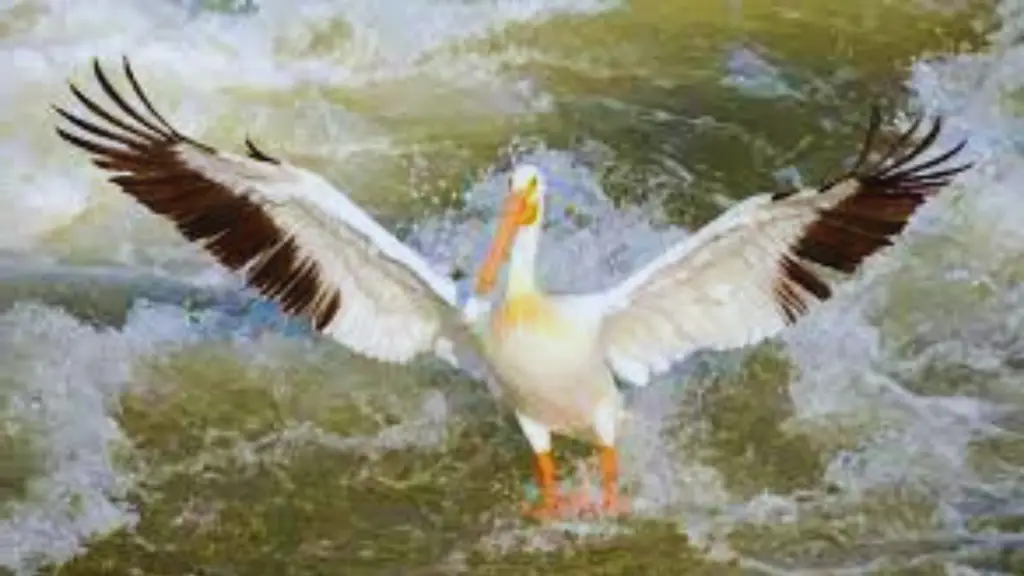
Witness the awe-inspiring grace and magnificence of the American White Pelican as its wings carry it effortlessly across the sky. This stunning bird captures the attention of anyone lucky enough to catch a glimpse. With its brilliant white plumage and impressive wingspan of up to nine feet, it is a sight to behold.
Found in North America, the American White Pelican is a true marvel of nature. It has a long, slender bill and a striking yellow throat pouch. These birds are highly skilled fishermen, using their keen eyesight to spot fish below the water’s surface. Once they locate their prey, they plunge into the water, scooping up fish in their pouches before resurfacing.
Not only are they magnificent in flight, but American White Pelicans are also social creatures. They often gather in large flocks, creating a captivating spectacle. These gatherings serve both as a means of protection and a way to find food. It is truly remarkable to witness the synchronized movements of these birds as they glide through the air, effortlessly keeping pace with one another.
The American White Pelican is a symbol of beauty and resilience. Despite facing habitat loss and pollution, these birds have managed to adapt and thrive. They remind us of the importance of preserving our natural environment and the incredible creatures that inhabit it.
So, next time you find yourself near a body of water, keep an eye out for the American White Pelican. You won’t be disappointed.
Barn Owl

Imagine yourself in the dark of night, when suddenly you hear the haunting call of a barn owl, its piercing screech echoing through the stillness. This magnificent bird, with its striking white and brown plumage, is a true beauty of the night. Known for its heart-shaped face and dark eyes, the barn owl has a ghostly appearance that captivates anyone lucky enough to witness it.
In addition to its stunning appearance, the barn owl possesses incredible hunting skills. With its keen sense of hearing, this nocturnal predator can locate prey in complete darkness. Its ability to fly silently allows it to swoop down on its unsuspecting victims without a sound. It’s truly a master of stealth.
To further highlight the unique features of the barn owl, take a look at the table below:
| Feature | Description |
|---|---|
| Heart-shaped face | Gives the barn owl a distinctive look |
| Dark eyes | Intense and mysterious |
| White and brown plumage | Provides excellent camouflage in its natural habitat |
| Silently flying | Allows for surprise attacks on prey |
| Nocturnal | Thrives in the darkness of night |
The barn owl is a remarkable creature that embodies both beauty and skill. Its presence in the night sky is a reminder of the wonders of nature and the incredible diversity of bird species in the world.
Great Egret

As you walk along the water’s edge, the graceful Great Egret glides silently overhead, its long, slender legs trailing behind like delicate brushstrokes against the evening sky. Its pure white plumage stands out against the lush green backdrop, making it a stunning sight to behold.
The Great Egret is known for its elegant appearance and majestic presence. With a wingspan of up to four feet, it soars effortlessly through the air, effortlessly riding the currents. Its neck, elongated and graceful, allows it to reach into the depths of the water to catch its prey with precision and skill.
Here are some fascinating facts about the Great Egret:
- Habitat:
- Great Egrets can be found in both freshwater and saltwater habitats, including wetlands, marshes, and coastal areas.
- They are known to nest in colonies, often alongside other bird species.
- Diet:
- The Great Egret primarily feeds on fish, but it also consumes amphibians, reptiles, and even small mammals.
- They use their sharp beaks to spear their prey, showing off their remarkable hunting prowess.
In conclusion, the Great Egret is not only a beautiful bird, but also a master of adaptation and survival. Its presence adds a touch of elegance to any natural setting, making it a true marvel to observe.
Snowy Egret
Take a moment to appreciate the Snowy Egret, with its elegant plumage and graceful movements that make you feel like you’re watching a ballet dancer on stilts. This beautiful white bird is truly a sight to behold. Standing at around 2 feet tall, the Snowy Egret is known for its long, slender neck and bright yellow feet that stand out against its snowy white feathers. With its piercing yellow eyes and slender black bill, it exudes a sense of elegance and sophistication.
To further engage you, let’s take a closer look at the Snowy Egret through a table:
| Feature | Description |
|---|---|
| Color | Snowy white feathers with black legs and yellow feet |
| Size | Approximately 2 feet tall |
| Habitat | Found near freshwater marshes, ponds, and coastal areas |
The Snowy Egret is a skilled hunter, using its long neck to search for fish, crustaceans, and other small aquatic creatures. It will patiently stalk its prey and then swiftly strike with its sharp bill. This bird is also known for its elaborate courtship displays, where it spreads its feathers, bows, and flaps its wings to attract a mate. So next time you spot a Snowy Egret, take a moment to admire its beauty and appreciate the grace it brings to the natural world.
Brown Pelican
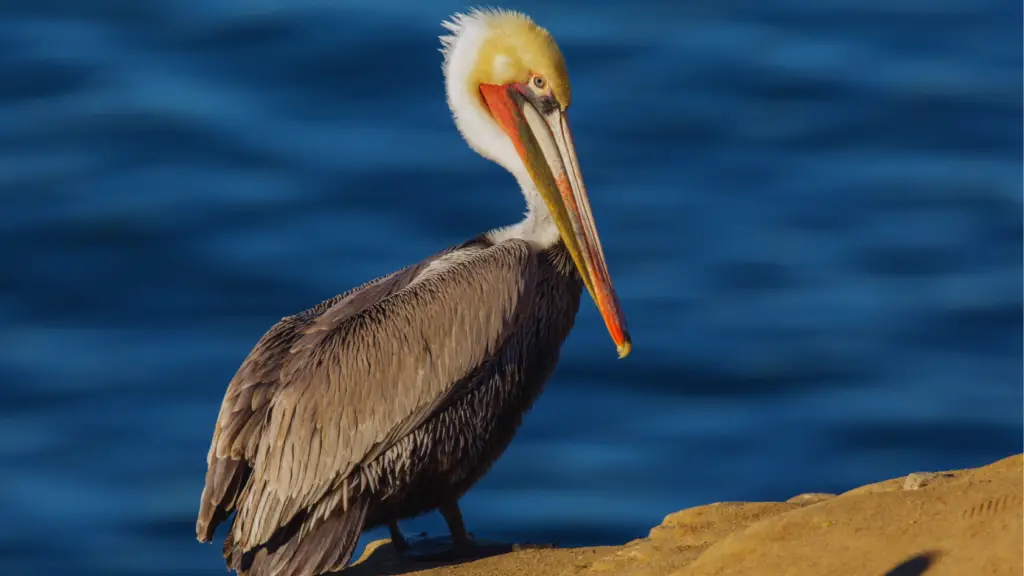
Get ready to be amazed by the captivating aerial acrobatics of the Brown Pelican. It effortlessly soars through the sky and dives into the water to catch its prey. This beautiful bird, with its elegant brown plumage, is a true spectacle to behold.
To give you a better idea of its remarkable characteristics, here are five fascinating facts about the Brown Pelican:
- With a wingspan of up to 7 feet, the Brown Pelican can glide gracefully for long distances, reaching impressive heights.
- When hunting for fish, they skillfully dive into the water from as high as 65 feet, using their keen eyesight to spot their prey.
- The Brown Pelican has a unique pouch beneath its bill that expands to hold up to 3 gallons of water. After catching fish, they drain the water and swallow their meal.
- Unlike most birds, the Brown Pelican can float on the water’s surface due to air sacs beneath its skin, making it an excellent swimmer.
- These pelicans are known for their distinctive, long bills, which are ideal for scooping up fish and small crustaceans.
So next time you have the chance to witness the Brown Pelican in action, take a moment to appreciate its incredible aerial displays and remarkable hunting skills. It truly is a magnificent sight to see.
White-tailed Kite
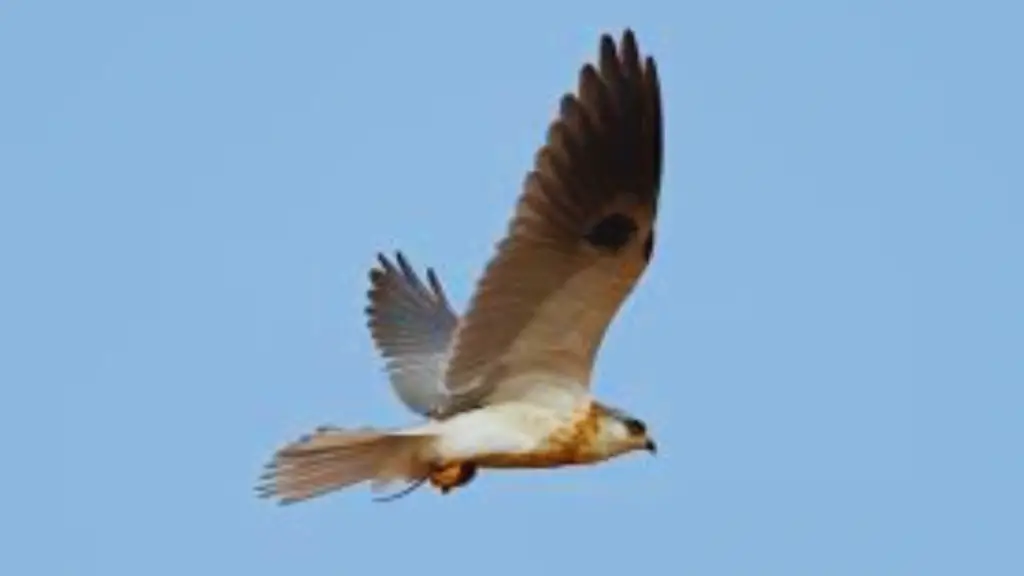
The White-tailed Kite gracefully dances across the sky, its wings painting the air with strokes of elegance. This beautiful bird is renowned for its stunning appearance and unique hunting techniques. With its white plumage, contrasting sharply against the blue sky, the White-tailed Kite is a sight to behold. Its long, slender wings and forked tail give it a distinctive silhouette as it soars effortlessly through the air.
These birds are master hunters, specializing in catching small rodents. With their keen eyesight and exceptional agility, they hover over open fields, scanning the ground for any signs of movement. Once they spot their prey, they plunge downward with lightning speed, snatching it up with their sharp talons. It is a display of precision and skill that few other birds can match.
The White-tailed Kite is also known for its elaborate courtship displays. Males will perform aerial acrobatics, soaring high into the sky and then diving towards the ground in a series of swoops and turns. These displays are not only a way to attract a mate but also a testament to the bird’s agility and strength.
In addition to its beauty and hunting prowess, the White-tailed Kite plays an important role in maintaining the balance of ecosystems. By controlling rodent populations, they help prevent damage to crops and other vegetation.
Overall, the White-tailed Kite is a magnificent bird that captivates with its grace and charm. Whether observed in flight or during its intricate courtship displays, it is truly a testament to the wonders of nature.
Northern Harrier
The Northern Harrier is a beautiful bird with long, graceful wings and a low-flying hunting style. It glides over marshes and fields, searching for prey with its keen eyes. You can easily spot the Northern Harrier by its distinctive white rump and brown plumage that blends perfectly with the surrounding vegetation.
This bird is known for its unique hunting technique. Instead of soaring high in the sky like other birds of prey, it flies close to the ground. It uses its keen sense of hearing to detect the slightest rustle of small mammals or birds. Once it spots its target, the Northern Harrier dives swiftly and executes precise mid-air maneuvers to capture its prey.
The Northern Harrier is a truly global species, found in North America, Europe, and Asia. It is often seen hovering above open grasslands, marshes, and agricultural fields, searching for voles, mice, and other small rodents. Its ability to adapt to different habitats and its stunning aerial displays make it a favorite among birdwatchers and nature enthusiasts alike.
So, if you ever have the chance to witness the Northern Harrier in action, be sure to marvel at its beauty and skill.
Osprey
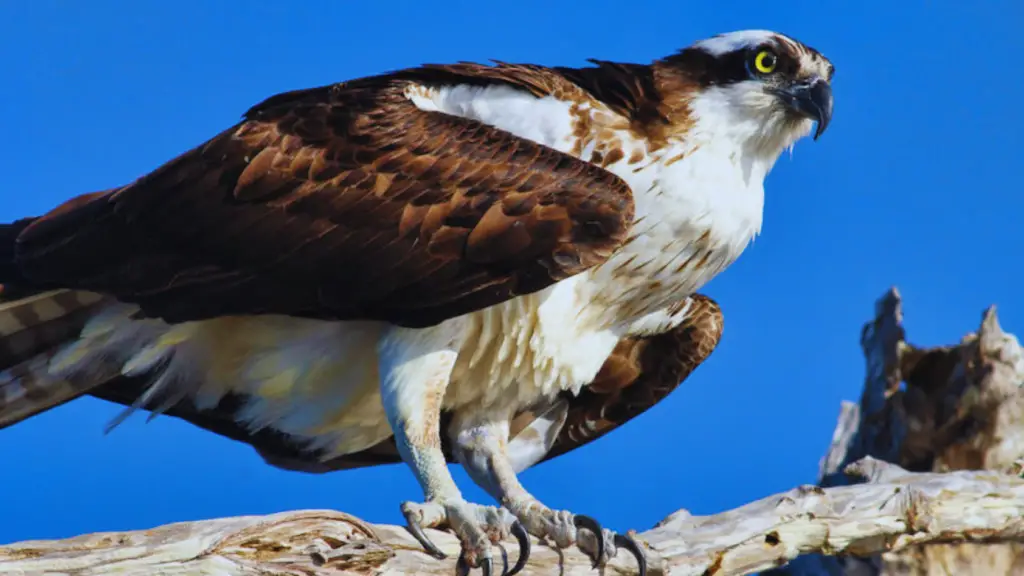
Flying high above the water, the Osprey is a skilled hunter, known for its ability to dive into the depths to catch fish. With its white head, dark brown back, and distinct white underparts, this bird boasts a striking appearance that captivates bird enthusiasts worldwide.
The Osprey is a medium-sized raptor, with a wingspan of up to six feet, allowing it to soar effortlessly through the sky. Its keen eyesight enables it to spot fish from great heights, and once it has located its prey, it hovers momentarily before plunging into the water feet-first. This impressive hunting technique is aided by its specially adapted feet, which have sharp, curved talons that can grip fish securely.
During breeding season, Ospreys construct large nests made of sticks, often on top of tall structures such as trees or utility poles. These nests can grow to be several feet in diameter and are reused year after year. Males and females work together to build and maintain the nest, demonstrating their strong bond.
The Osprey’s range spans across six continents, making it one of the most widely distributed birds of prey in the world. Its adaptability and resilience have allowed it to thrive in various habitats, including coastal regions, lakes, and rivers.
Whether you spot an Osprey soaring through the sky or witness its incredible fishing prowess, this beautiful bird is sure to leave you in awe of nature’s wonders.
White And Brown Birds FAQs
What is the average lifespan of a Snowy Owl?
The average lifespan of a snowy owl is around 10 years. These majestic birds are known for their stunning white plumage and are well adapted to live in cold Arctic environments.
How do Bald Eagles build their nests?
Bald eagles build their nests by using large sticks and branches. They line the nest with softer materials like grass and moss. The female takes the lead in nest construction, while the male provides materials.
What is the diet of the American White Pelican?
You’re dying to know what the American white pelican eats, huh? Well, brace yourself for some mind-blowing information – these majestic creatures survive on a diet of fish. Yep, just fish. Exciting, right?
What is the difference between a Barn Owl and a Great Horned Owl?
The barn owl and great horned owl are both nocturnal birds of prey, but they have distinct differences. The barn owl has a heart-shaped face and hunts rodents, while the great horned owl has prominent ear tufts and preys on a variety of animals.
How does the Brown Pelican catch fish?
The brown pelican is an amazing fisherman! Did you know that it can dive from heights of up to 60 feet and plunge into the water at speeds of 40 miles per hour? Impressive, right?
Conclusion
So there you have it, the top 10 most beautiful white and brown birds!
From the majestic Snowy Owl to the powerful Bald Eagle, these birds captivate with their stunning plumage.
Whether it’s the grace of the Great Egret or the elegance of the Barn Owl, each bird brings its own unique charm.
So next time you’re out in nature, keep an eye out for these amazing creatures.
You’re sure to be enchanted by their beauty.






